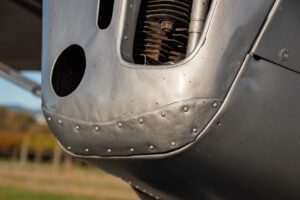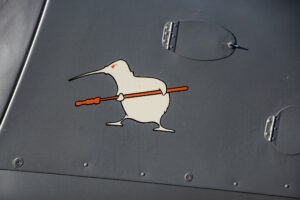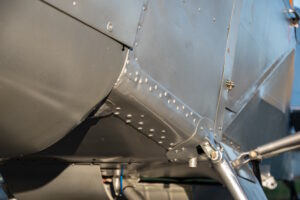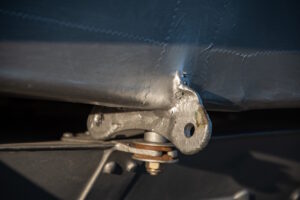By Grant Newman
Following a two-year full restoration, a historic Royal New Zealand Air Force (RNZAF) Auster has been brought back to life again. Formerly decorated as a civilian machine, Auster J/5 NZ1701 emerged wearing authentic RNZAF markings after former owner, Auster aficionado John Kelly, stripped the aircraft to its bare structure and began refurbishing it to match the condition it was in when it operated with the RNZAF. Incorporating other ex-RNZAF Auster parts, it is as authentic as a modern rebuild to flying condition can be, with the obvious concessions to operating it in the modern aviation environment. The wooden trim surrounding the windows was skilfully handcrafted by Kelly, who also recovered the aircraft with fabric.
![[Photo by Grant Newman]](https://vintageaviationnews.com/wp-content/uploads/Auster-NZ1701-Cockpit-Grant-Newman-1024x683.jpg)
Kelly’s association with the type is a long one, having restored and operated Auster VH-WMM in Australia, towing its remains across the Nullabor Plain from St Arnaud, Victoria, to Kalgoorlie, Western Australia to overhaul it. That particular aircraft now resides in New Zealand as ZK-AGY. In depicting NZ1701 in its Air Force markings, Kelly contacted the Air Force Museum of New Zealand, where its color scheme and markings were carefully researched. On its nose is a cartoon Kiwi clutching a Taiaha, a Maori club-type weapon. This marking is a personal addition by Kelly himself.
One of a total of seven Austers acquired for RNZAF service as communications and liaison aircraft, NZ1701 arrived in New Zealand by sea in 1947. The first six Austers were bought for the sum of £1,200 each. When delivered, they were engineless and they were fitted with surplus 130 hp de Havilland Gipsy Major I engines on arrival, as opposed to the Auster J/1’s usual 100 hp Blackburn Cirrus Minor engine. The Gipsy engines fitted to the Austers were surplus de Havilland Tiger Moth engines. After construction to flying condition at RNZAF Base Ohakea, NZ1701 was sent to RNZAF Base Rongotai, Wellington to serve with the Communications Flight. During this time it operated from Rotorua for fire patrols for the New Zealand Forestry Service.
In 1952 NZ1701 was transferred to RNZAF Base Hobsonville and was fitted with floats for operation as a seaplane. The brackets for fitting the floats have been incorporated into the aircraft’s restoration. At Hobsonville, the aircraft was used for training personnel on handling aircraft on the water for flying boat operations. After a relatively short RNZAF career of eight years, NZ1701 was sold by tender to the Piako Aero Club in February 1956, receiving the registration ZK-BQL after emerging as a civilian aircraft two years later. After being passed through various owners’ hands, the aircraft suffered an accident at Omaka in 1988, but was rebuilt again. After he bought it, Kelly did much of the restoration himself. He acquired the aircraft’s wheeled undercarriage from an ex-RNZAF airframe engineer who held onto them following the aircraft’s conversion to a floatplane. The aircraft was re-registered as ZK-BQS in February 2022, but Kelly has since sold it to an operator who he felt would appreciate its history.
![[Photo by Grant Newman]](https://vintageaviationnews.com/wp-content/uploads/Auster-NZ1701-Grant-Newman-01-1024x683.jpg)
During its time at Rongotai, NZ1701 was featured in a photo shoot by an Evening Post reporter as part of an RNZAF recruitment drive on 22 June 1950 with a young boy by the name of Robert Mann, who was photographed in front of the aircraft. The photo set was appropriately named “Robert goes to Rongotai” and depicts Mann at various times during his visit to the airport that day. Kelly has a copy of the image and on the aircraft’s completion was keen to recreate the photo featuring Mann confronting NZ1701. On 11 May 2022, on a sunny afternoon outside Kelly’s hangar at a private airstrip near Nelson, a photoshoot took place that recreated the original image that Kelly has a copy of, with his friend Rob Boult as a stand-in for Mann. Boult was brought along to replicate Mann’s possible age as he would be today.
The author would like to thank John Kelly, Rob Boult, and Andy Heap for their assistance in preparing this article.





